Release Date :
Reference Number :
RSSO XI-2017-005
Total population went up by 424 thousand persons
• As of 1 August 2015, Davao Region had a total population of 4,893,318 persons based on the 2015 Census of Population (POPCEN 2015).
• The total population based on the POPCEN 2015 is higher by 424,755 persons compared with the 2010 Census of Population and Housing (CPH) count of 4,468,563 persons. Based on the 2007 Census of Population (POPCEN 2007), the total population was 4,159,469 persons.
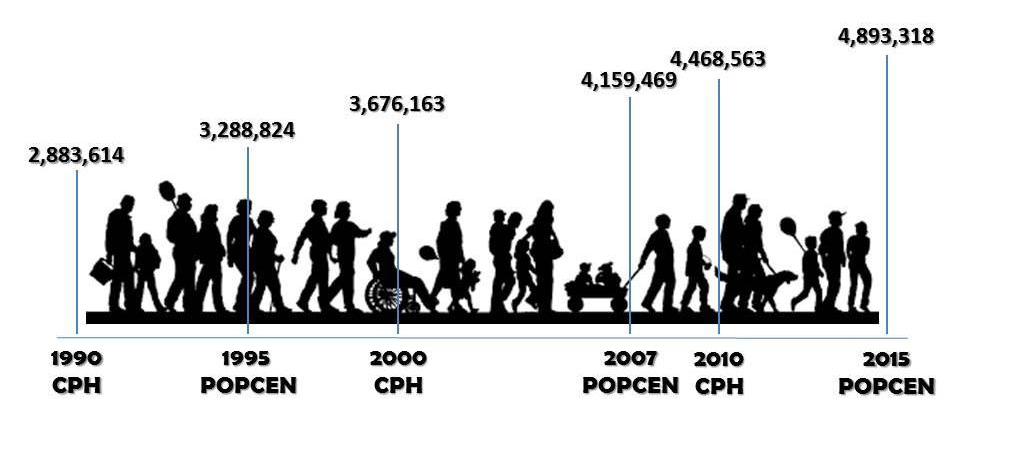
Population increased by 17 persons per year for every 1,000 persons
• The increase in Davao Region population translated to an average population growth rate (PGR) of 1.74 percent annually during the period 2010 to 2015. This means that there were about 17 persons added per year for every 1,000 persons in the population.
• The annual PGR was higher at 1.97 percent during the period 2000 to 2010 and at 2.46 percent during the period 1990 to 2000.
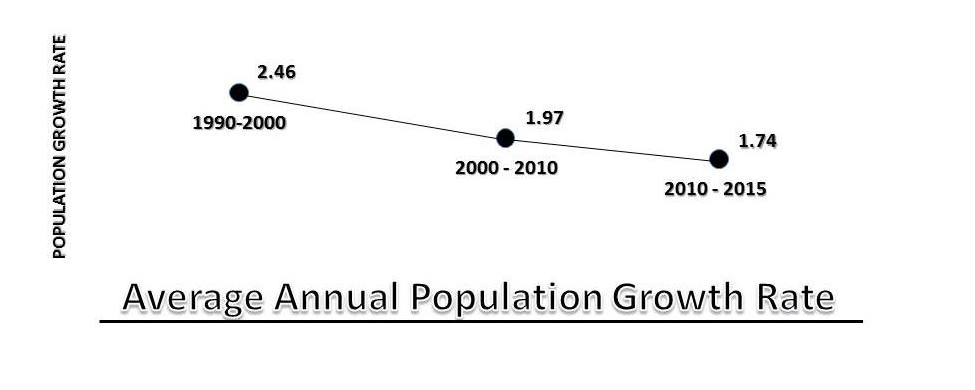
One in every three persons in the region is residing in Davao City
• One in every three persons in the region is residing in Davao City, the region’s Highly Urbanized City (HUC). Davao City posted 1,632,991 persons in 2015 and among the four HUCs that surpassed the one million population mark: namely, Quezon City (2.94 million), City of Manila (1.78 million), Davao City (1.63 million),
and Caloocan City (1.58 million).
• Davao City was growing at an average annual population growth rate (PGR) of 2.30 percent. If the current annual population growth rate of the city continues, the population of Davao City was expected to double in 50.6 years.
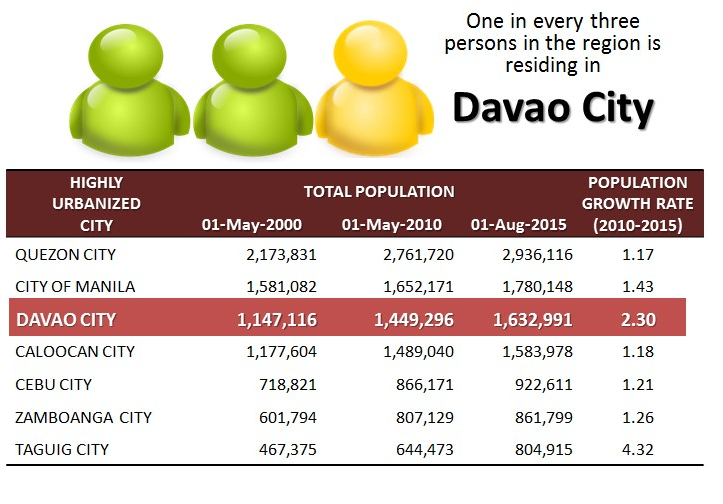
Davao del Norte reached more than one million population
• Of the region’s 5 provinces, Davao del Norte had the biggest population in 2015 with 1,016,332 comprising about 20 percent of the total population of the region. This is followed by Compostela Valley with 736,107 persons.
• Davao del Sur is the fastest growing province compared to other provinces in the region, growing at an average annual population growth rate (PGR) of
1.84 percent.
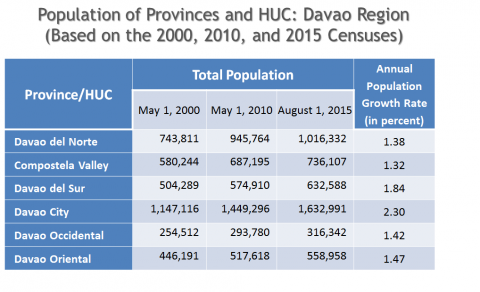
Males outnumbered females
• Of the total population, 51.4 percent were males while 48.6 percent were females. This resulted to a sex ratio of 106 males for every 100 females. The sex ratio was reported in 2010 was 105.
• Compostela Valley posted the highest sex ratio of 110. Moreover, Davao City posted the smallest sex ratio with 102.
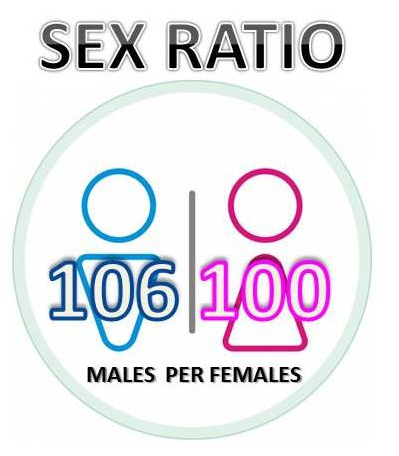
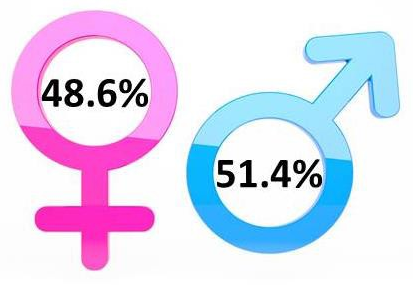
Median age is 22.86 years
• In 2015, the median age of the region’s total population was 22.86 years, which means that half of the total population was below 22.86 years old. Median age was highest in Davao del Sur (23.74 years) and lowest in Davao Occidental (20.24 years).
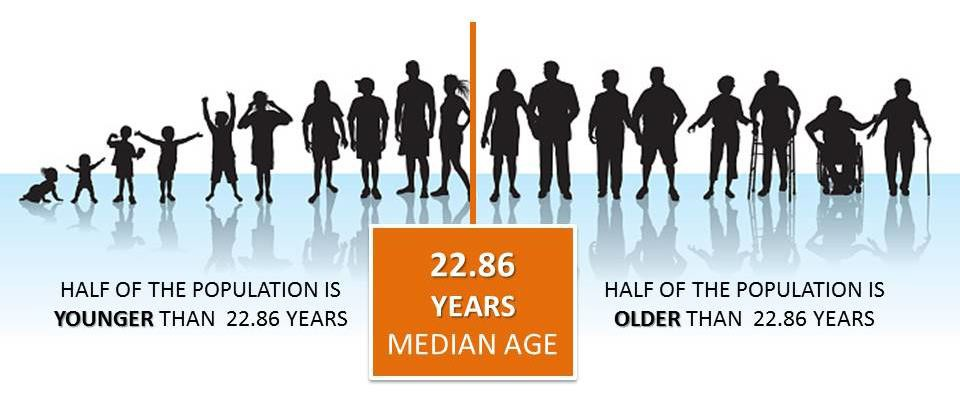
Average household size in 2015 was 4.1 persons
• The household population of the region in 2015 was 4,867,168 persons, higher by 414,619 persons from the household population of 4,452,549 persons in 2010.
• The number of households, meanwhile, increased by 16.4 percent from 1,011,943 in 2010 to 1,177,461 in 2015.
• The average household size in 2015 was 4.1 persons, lower than the average household size of 4.4 persons in 2010.

Children aged 0 to 4 years comprised the largest age groups
• The age-sex distribution of the population showed that children aged 0 to 4 years comprised the largest age group with 11.0 percent of the total population, followed by those in the age groups and 5 to 9 years (10.9 percent), 10 to 14 years (10.3 percent) and 15 to 19 years (10.1 percent).
• Males outnumbered females in the age groups 0 to 59 years. Females, on the other hand, outnumbered their male counterparts in the older age groups (60 years old and over).
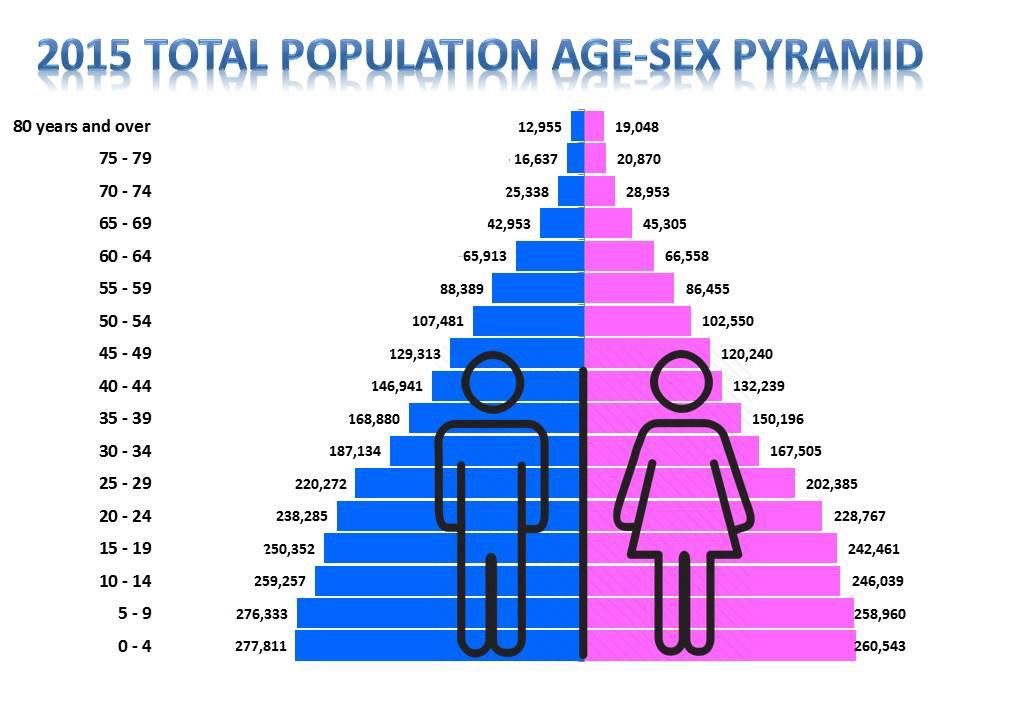
Dependency ratio decreased to 58 dependents per 100 persons in the working- age group
• Of the total population, 63.4 percent belonged to the working-age population (15 to 64 years). Children below 15 years of age comprised 32.3 percent while older persons (65 years and over) accounted for 4.3 percent.
• The overall dependency ratio of Davao Region in 2015 was 58 dependents for every 100 persons in the working age group, down from 59 dependents in 2010. Of the 58 dependents, 51 were young dependents while seven were old dependents.
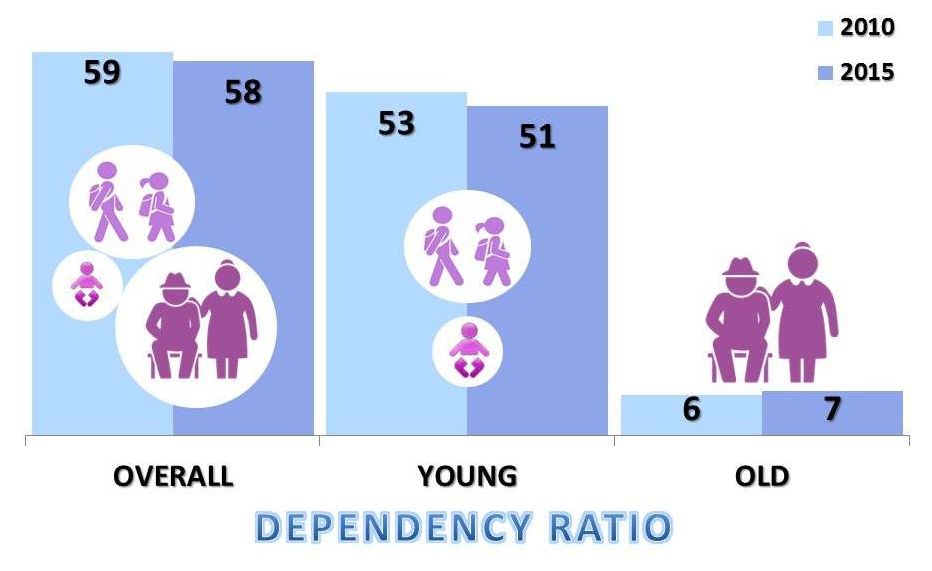
Three fifths of the total population were of voting age
• The voting-age population or persons 18 years old and over accounted for 61.7 percent (3,018,187 persons) of the total population in 2015.
• The highest proportion of voting-age population was posted by Davao City (63.6 percent) followed by Davao del Sur (62.5 percent) and Davao del Norte (62.2 percent). Davao Occidental had the lowest proportion of voting-age population with 56.4 percent.
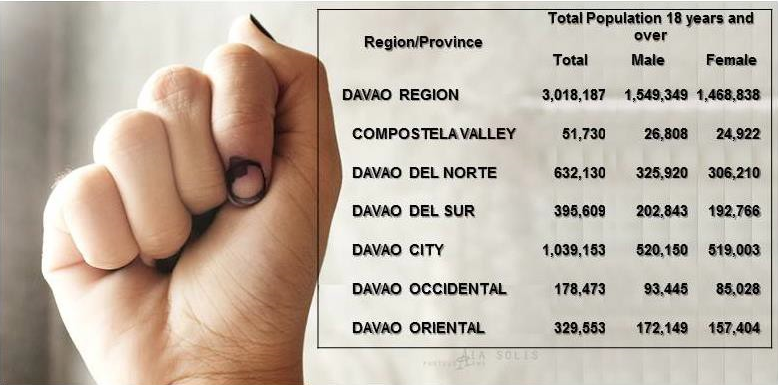
More males than females among never-married
• Of the total population 10 years old and over, 42.7 percent were never married while 41.3 percent were married. The rest of the total population was categorized as follows: in common law/live-in marital arrangement (10.4 percent), widowed (4.2 percent), divorced/separated (1.3 percent), and had unknown marital status (0.1 percent).
• A higher proportion of males (55.7 percent) than females (44.3 percent) were reported among the never-married persons. Meanwhile, the proportion of females was higher than males among those who were widowed (74.3 percent), divorced/separated (56.4 percent) and in common law/live-in marital arrangement (50.2 percent).

Females outnumbered males among academic degree holders
• Of the total population 5 years old and over, 37.2 percent had attended or completed elementary education, 36.0 percent had reached or finished high school, 9.9 percent were college undergraduates, and 8.9 percent were academic degree holders.
• Among those with academic degrees, there were more females (57.0 percent) than males (43.0 percent). Similarly, among those with post baccalaureate courses, females (56.0 percent) outnumbered males (44.0 percent).
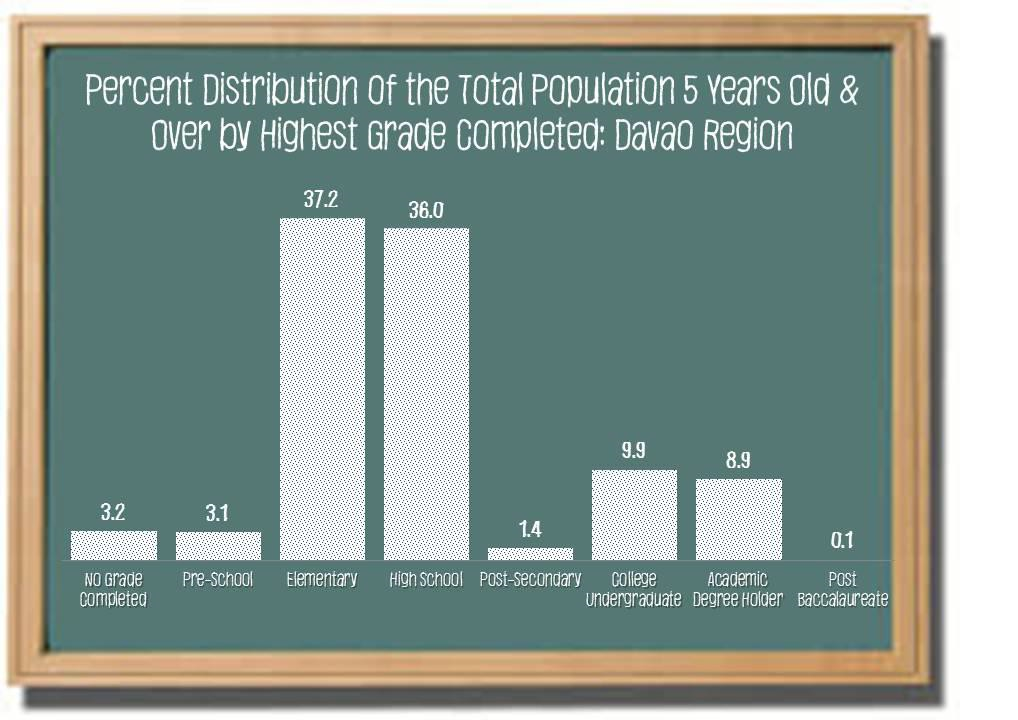
School attendance rate was higher among females than among males
• Of the 1,990,682 household population aged 5 to 24 years, 68.0 percent were attending school in School Year (SY) 2015-2016.
• By sex, the school attendance rate in 2015 was higher among females (69.4 percent) than among males (68.6 percent).
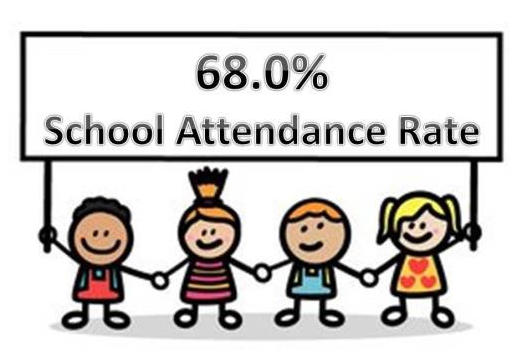
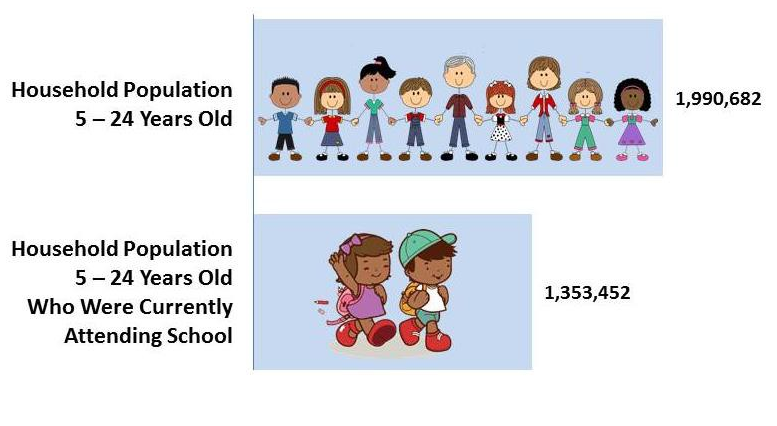
Simple literacy rate was recorded at 97.9 percent
• Davao Region posted a literacy rate of 97.9 percent among the 3,793,848 household population aged 10 years old and over. A person is considered literate if he/she is able to read and write a simple message in any language or dialect.
• Literacy rate in 2015 was slightly higher among females (98.0 percent) than among males (987.8 percent).
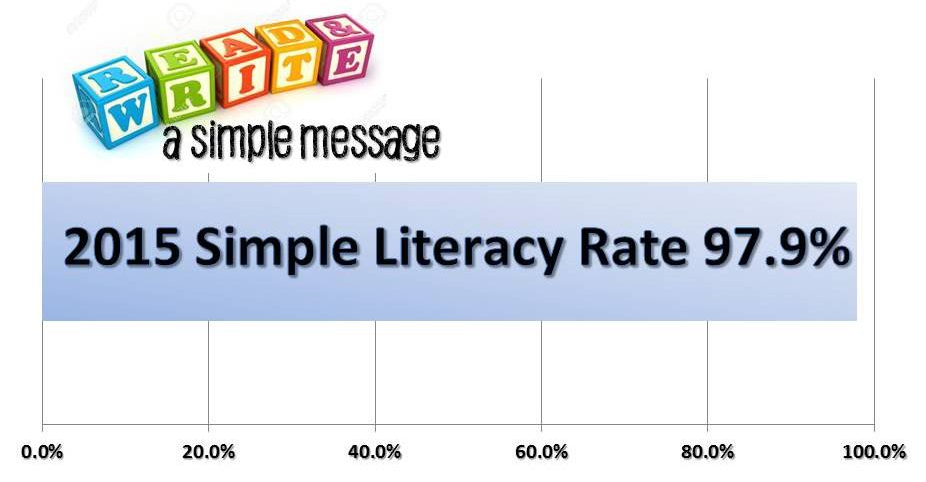
Roman Catholics accounted for 75 percent of the total population
• Almost three fourths (74.5 percent or 3,646,453persons) of the total population of Davao Region in 2015 reported Roman Catholic as their religious affiliation.
• The next largest religious affiliation in the country was Evangelicals (Philippine Council of Evangelical Churches), comprising 6.7 percent of the total population. It was followed by those who were affiliated with Islam with 3.4 percent share.
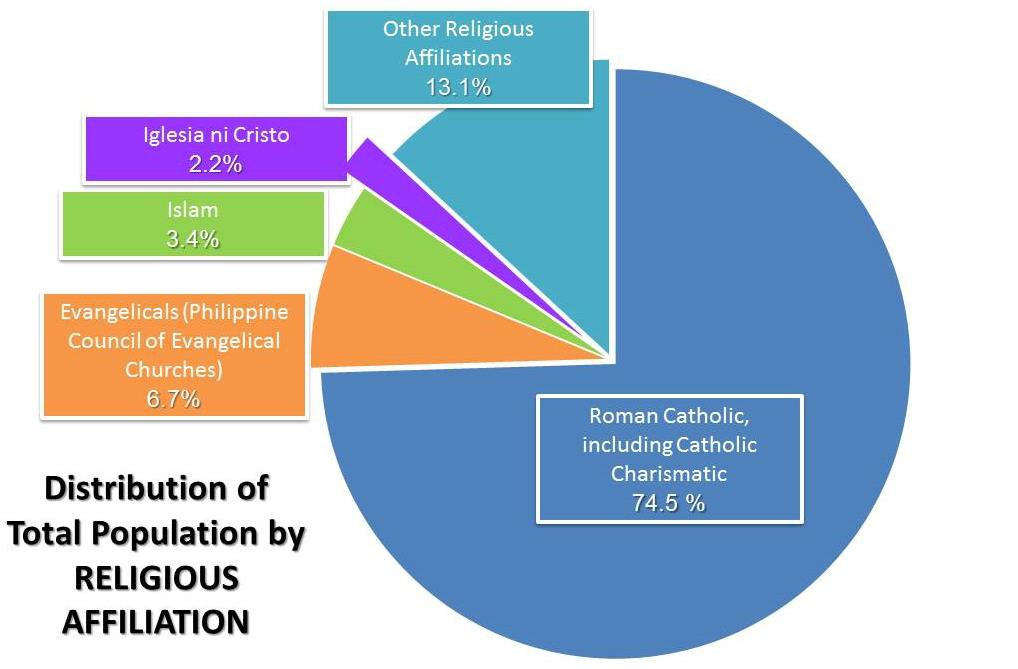
Almost three in every five persons were engaged in gainful activity
• In 2015, the region had 3,289,112 household population aged 15 years and over. Of this total, approximately three in every five persons (57.7 percent) were engaged in a gainful activity during the 12 months preceding the census.
• By major occupation group, workers engaged in elementary occupations comprised the largest group (26.4 percent of the total gainfully active persons). Skilled agricultural, forestry, and fishery workers came in next (20.1 percent), followed by service and sales workers (14.0 percent).
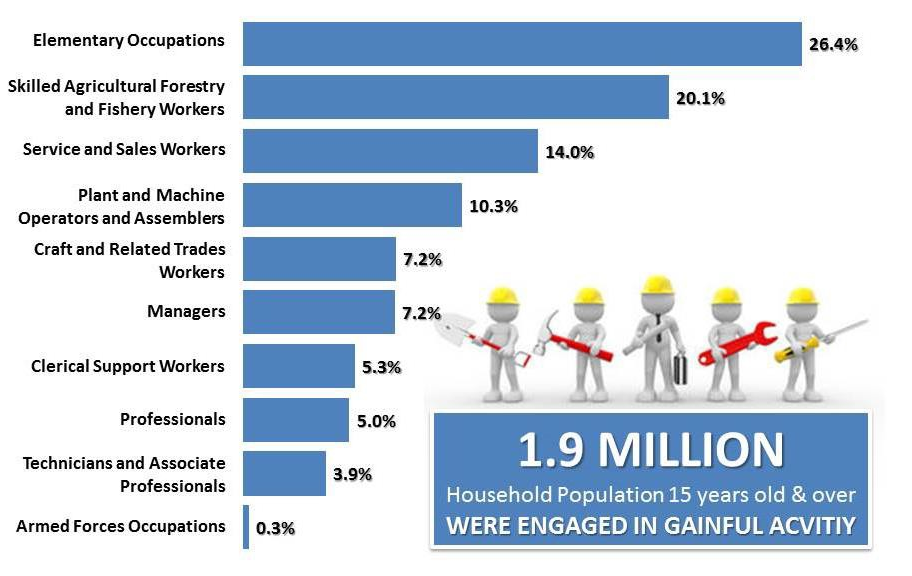
About 3.2 percent of the household population were overseas workers
• Of the household population 15 years old and over, 6,907 persons or 1.9 percent were overseas workers. Overseas workers aged 25 to 29 years made up the largest age group, comprising 22.2 percent of the total overseas workers, followed by those in the age groups 30 to 34 years (21.7 percent), and 35 to 39 years (18.0 percent).
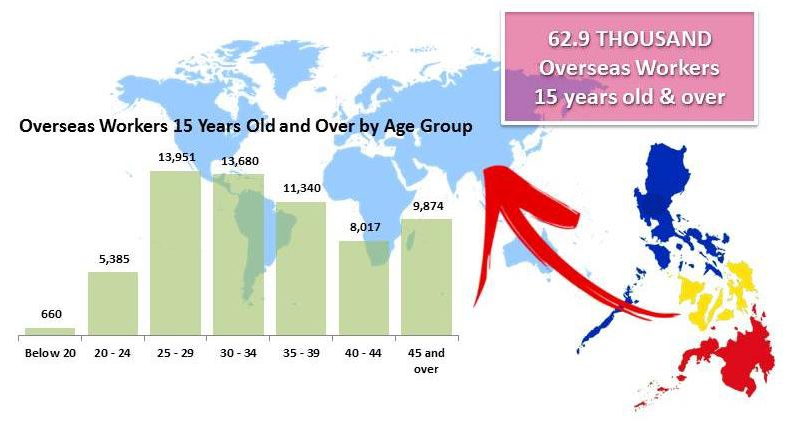
TECHNICAL NOTES
Population growth - the rate at which the population is increasing (or decreasing) in a given period due to natural increase and net migration, expressed as a percentage of the base population
Total population - the sum of the household population and institutional population. It also includes Filipinos in Philippine embassies, consulates, and missions abroad
Household population - comprises of persons who belong to a household, the basic criterion of which is the usual place of residence or the place where the person usually resides
Institutional population - the population enumerated in collective or institutional living quarters such as: dormitories/lodging houses, jails/prisons, military camps, convents/seminaries, and mental hospitals
Household - a social unit consisting of a person living alone or a group of persons who sleep in the same housing unit and have a common arrangement in the preparation and consumption of food
Average household - size the average number of persons who live in the household, computed as the household population in a given area divided by the corresponding total number of households in that area
Head of the household - an adult person, male or female, who is responsible for the organization and care of the household, or who is regarded as such by the members of the household
Sex ratio- the ratio of males to females in a given population, expressed as the number of males per 100 females
Age - the interval of time between a person’s date of birth and the census reference date (1 August 2015). Expressed in completed years (as of last birthday), it is recorded in whole number
Median age - the age at which exactly half of the population is younger than this age and the other half is older than it
Overall dependency - ratio the ratio of persons in the dependent ages (under 15 years old and over 64 years old) to persons in the economically active or working ages (15 to 64 years old) in the population
Marital status - the personal status of each individual with reference to the marriage laws or customs of the country
Religious affiliation - a particular system of beliefs, attitudes, emotions, and behaviors constituting man’s relationship with the powers and principalities of the universe
School attendance - rate the proportion of persons 5 to 24 years old who were attending school during the School Year June 2015 to March 2016 to school- age population (5 to 24 years old)
Simple literacy rate - the proportion of persons aged 10 years and over who are able to read and write a simple message in any language or dialect
Highest grade / year completed - the highest grade or year completed in school, college or university
Usual activity / occupation - the kind of job or business, which a person aged 15 years and over was engaged in most of the time during the 12 months preceding the census
Overseas worker - a household member (15 years old and over) who is out of the country due to an overseas employment
The 2015 Census of Population (POPCEN 2015) was undertaken by the Philippine Statistics Authority (PSA) in August 2015 as mandated by Republic Act No. 10625, otherwise known as the Philippine Statistics Act of 2013. It was the 14th census of population that was undertaken since the first census in 1903. POPCEN 2015 was designed to take an inventory of the total population all over the Philippines and collect information about their characteristics. Census day for the POPCEN 2015 was August 1, 2015 (12:01 a.m.). POPCEN 2015 made use of the de jure concept of enumeration wherein households and persons are enumerated in the area where they usually reside as of the census reference date. Enumeration lasted for about 25 days, from 10 August to 6 September 2015. Enumeration was extended until 15 September 2015 for large provinces and some highly urbanized cities.
